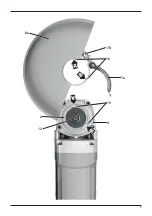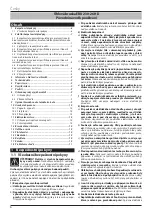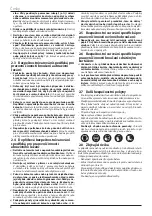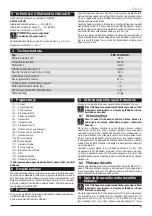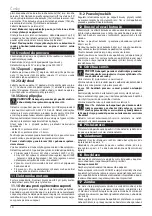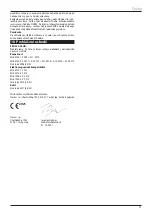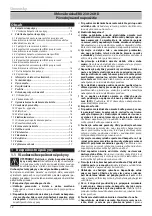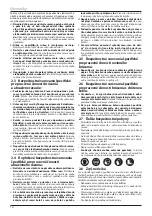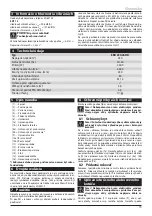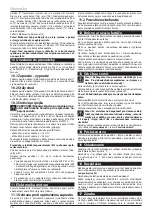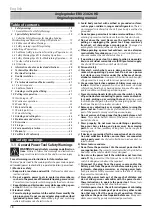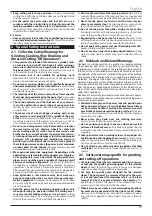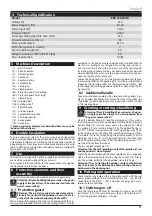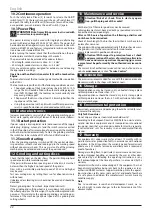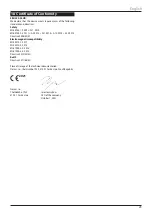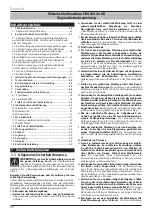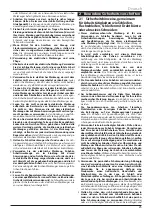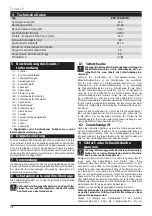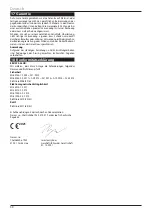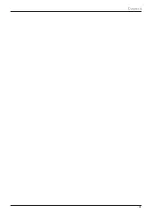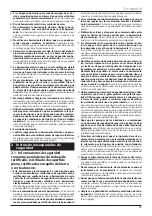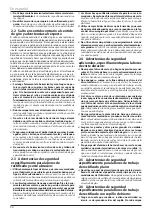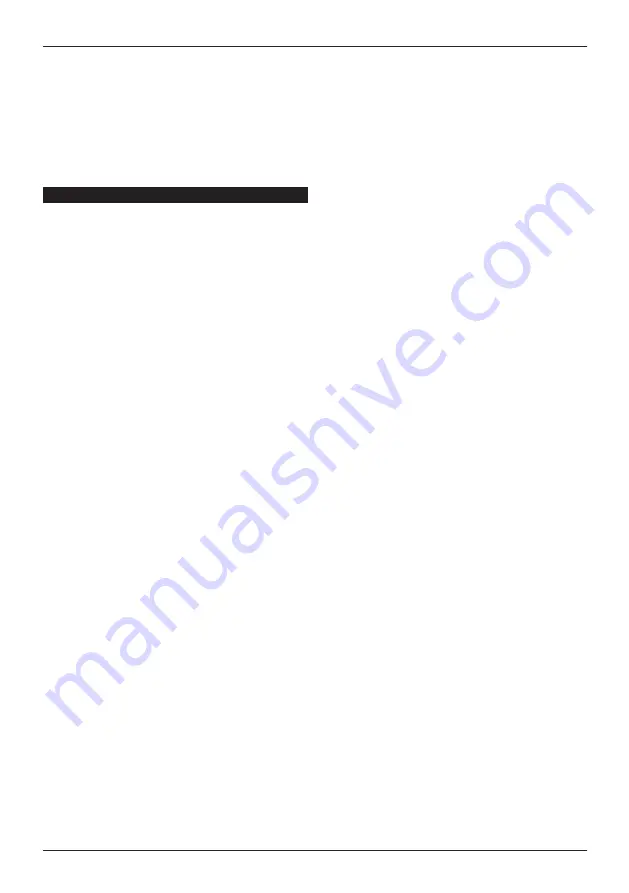
English
19
f)
Keep cutting tools sharp and clean.
Properly maintained
cutting tools with sharp cutting edges are less likely to bind
and are easier to control..
g)
Use the power tool, accessories and tool bits etc. in ac-
cordance with these instructions, taking into account the
working conditions and the work to be performed.
Use of
the power tool for operations different from those intended
could result in a hazardous situation.
5) Service
a)
Have your power tool serviced by a qualified repair person
using only identical replacement parts.
This will ensure that
the safety of the power tool is maintained.
2 Special Safety Instructions
2.1 Collective Safety Warnings for
Grinding, Sanding, Wire Brushing and
Abrasive Cutting-Off Operations:
a)
This power tool is intended to function as a grinder, sand-
er, wire brush and cut-off tool. Read all safety warnings,
instructions, illustrations and specifications provided with
this power tool.
Failure to follow all the instructions may re-
sult in electric shock, fire and/or serious injury.
b)
This power tool is not suitable for polishing work.
Operations for which the power tool was not designed may
create a hazard and cause personal injury.
c)
Do not use accessories which are not specifically designed
and recommended by the tool manufacturer.
Just because
the accessory can be attached to your power tool, it does not
assure safe operation.
d)
The rated speed of the accessory must be at least equal to
the maximum speed marked on the power tool.
Accessories
running faster than their rated speed can break and fly apart.
e)
The outside diameter and the thickness of your accesso-
ry must be within the capacity rating of your power tool.
Incorrectly sized accessories cannot be adequately guarded
or controlled.
f)
The arbour size of wheels, flanges, backing pads or any
other accessory must properly fit the spindle of the pow-
er tool.
Accessories with arbour holes that do not match the
mounting hard-ware of the power tool will run out of bal-
ance, vibrate excessively and may cause loss of control.
g)
Do not use a damaged accessory. Before each use inspect
the accessories such as abrasive wheels for chips and
cracks, backing pads for cracks, tear or excess wear, wire
brushes for loose or cracked wires. If power tool or accesso-
ry is dropped, inspect for damage or install an undamaged
accessory. After inspecting and installing an accessory,
position yourself and bystanders away from the plane of
the rotating accessory and run the power tool at maximum
no-load speed for one minute.
Damaged accessories will
normally break apart during this test time.
h)
Wear personal protective equipment. Depending on the
application, use face shield, safety goggles or safety glass-
es. As appropriate, wear a dust mask, hearing protectors,
gloves and a workshop apron capable of stop-ping small
abrasive or workpiece fragments.
The eye protection must
be capable of stopping flying debris generated by various
operations. The dust mask or respirator must be capable of
filtering particles generated by your operation. Prolonged ex-
posure to high intensity noise may cause hearing loss.
i)
Keep bystanders a safe distance away from work area.
Anyone entering the work area must wear personal pro-
tective equipment.
Fragments of workpiece or of a broken
accessory may fly away and cause injury beyond immediate
area of operation.
j)
Hold the power tool by insulated gripping surfaces only
when performing an operation where the cutting acces-
sory may contact hidden wiring or its own cord.
Cutting
accessory contacting a “live” wire may make exposed metal
parts of the power tool “live” and shock the operator.
k)
Position the cord clear of the spinning accessory.
If you lose
control of the power tool, the cord may be cut or snagged and
your hand or arm may be pulled into the spinning accessory.
l)
Never lay the power tool down until the accessory has
come to a complete stop.
The spinning accessory may catch
the surface and pull the power tool out of your control.
m)
Do not run the power tool while carrying it at your side.
Accidental contact with the spinning accessory could snag
your clothing, pulling the accessory into your body.
n)
Regularly clean the power tool’s air vents.
The motor’s fan
will draw the dust inside the housing and excessive accumu-
lation of powdered metal may cause electrical hazards.
o)
Do not operate the power tool near flammable materials.
Sparks could ignite these materials.
p)
Do not use accessories that require liquid coolants.
Using
water or other liquid coolants may result in electrocution or
shock.
2.2 Kickback and Related Warnings
Kickback is a sudden reaction to a pinched or snagged rotating
wheel, backing pad, brush or any other accessory. Pinching or
snagging causes rapid stalling of the rotating accessory which in
turn causes the uncontrolled power tool to be forced in the direc-
tion opposite of the accessory’s rotation at the point of the binding.
For example, if an abrasive wheel is snagged or pinched by the
workpiece, the edge of the wheel that is entering into the pinch
point can dig into the surface of the material causing the wheel to
climb out or kick out. The wheel may either jump toward or away
from the operator, depending on direction of the wheel’s move-
ment at the point of pinching. Abrasive wheels may also break
under these conditions.
Kickback is the result of power tool misuse and/or incorrect operat-
ing procedures or conditions and can be avoided by taking proper
precautions as given below.
a)
Maintain a firm grip on the power tool and position your
body and arm to allow you to resist kickback forces. Always
use an auxiliary handle, if provided, for maximum control
over kickback or torque reaction during start-up.
The oper-
ator can control torque reactions or kick-back forces, if proper
precautions are taken.
b)
Never place your hand near the rotating accessory.
Accessory may kickback over your hand.
c)
Do not position your body in the area where power tool
will move if kickback occurs.
Kick-back will propel the tool
in direction opposite to the wheel’s movement at the point of
snagging.
d)
Take special care when working corners, sharp edges etc.
Avoid bouncing and snagging the accessory.
Corners, sharp
edges or bouncing have a tendency to snag the rotating ac-
cessory and cause loss of control or kickback.
e)
Do not attach a saw chain woodcarving blade or toothed
saw blade.
Such blades create frequent kickback and loss of
control.
2.3 Safety warnings specific for grinding
and cutting-off operations:
a)
Use only wheel types that are recommended for your pow-
er tool and the specific guard designed for the selected
wheel.
Wheels for which the power tool was not designed
cannot be adequately guarded and are unsafe.
b)
Use only the specific guard designed for the selected
wheel. The guard must be securely attached to the pow-
er tool and positioned for maximum safety, so the least
amount of wheel is exposed towards the operator.
The
guard helps to protect the operator from broken wheel frag-
ments and accidental contact with the wheel.
c)
Wheels must be used only for recommended applications.
For example: do not grind with the side of cut-off wheel.
Abrasive cut-off wheels are intended for peripheral grind-
ing, side forces applied to these wheels may cause them to
shatter.
Summary of Contents for EBU 230-26 HD
Page 4: ...4 1 2 3 3 4 5 5 5 6 7a 7b 8a 8b 9 9 10a 10b 10b 11 11 12 13 14 7b 7a...
Page 5: ...5 4 6 7a 7b 8a 12 15 16...
Page 31: ...Deutsch 31...
Page 51: ...o 51 4 a 5 a 2 2 1 a...
Page 52: ...o 52 2 2 a 2 3 2 4...
Page 57: ...o 57...

